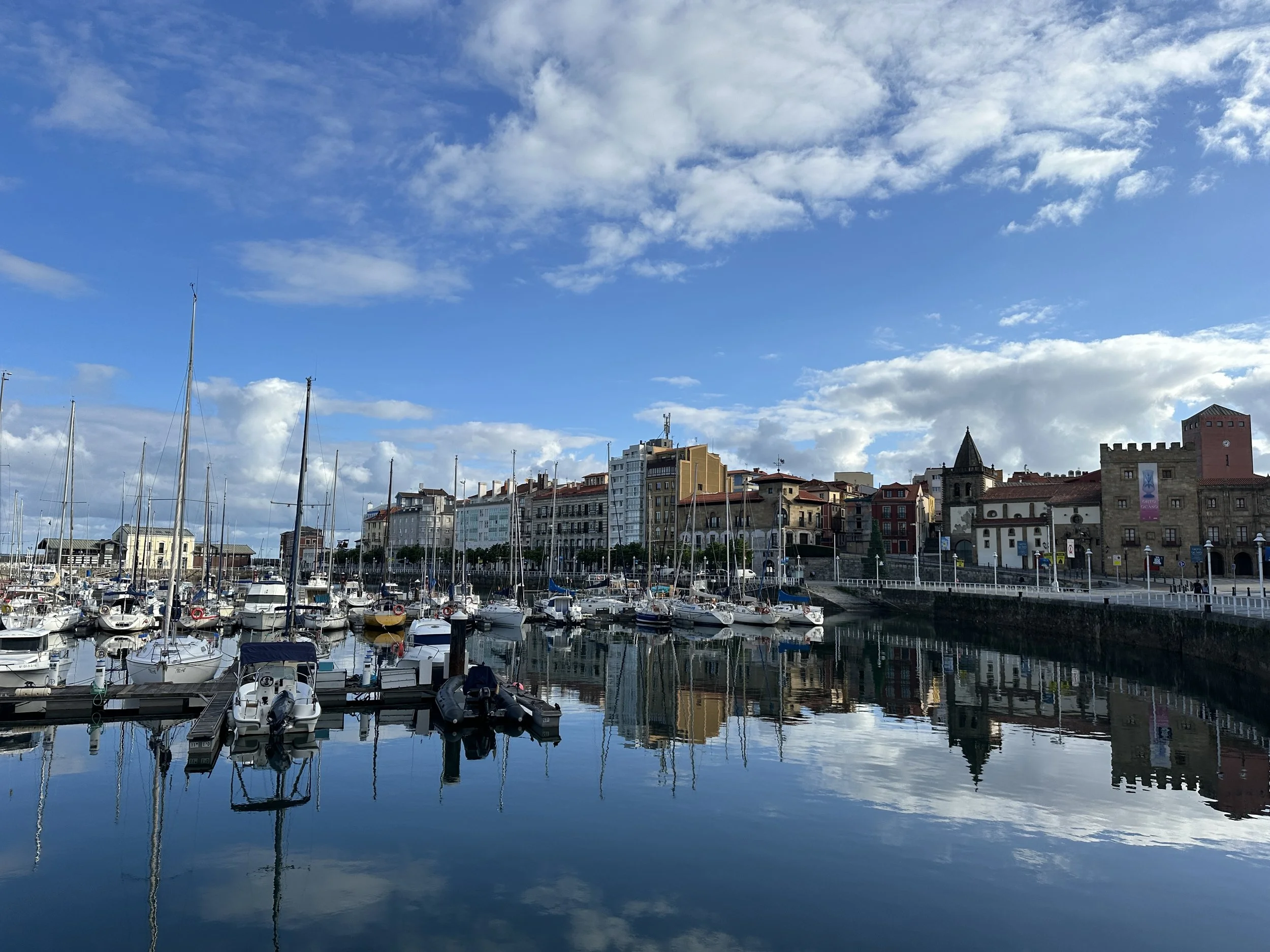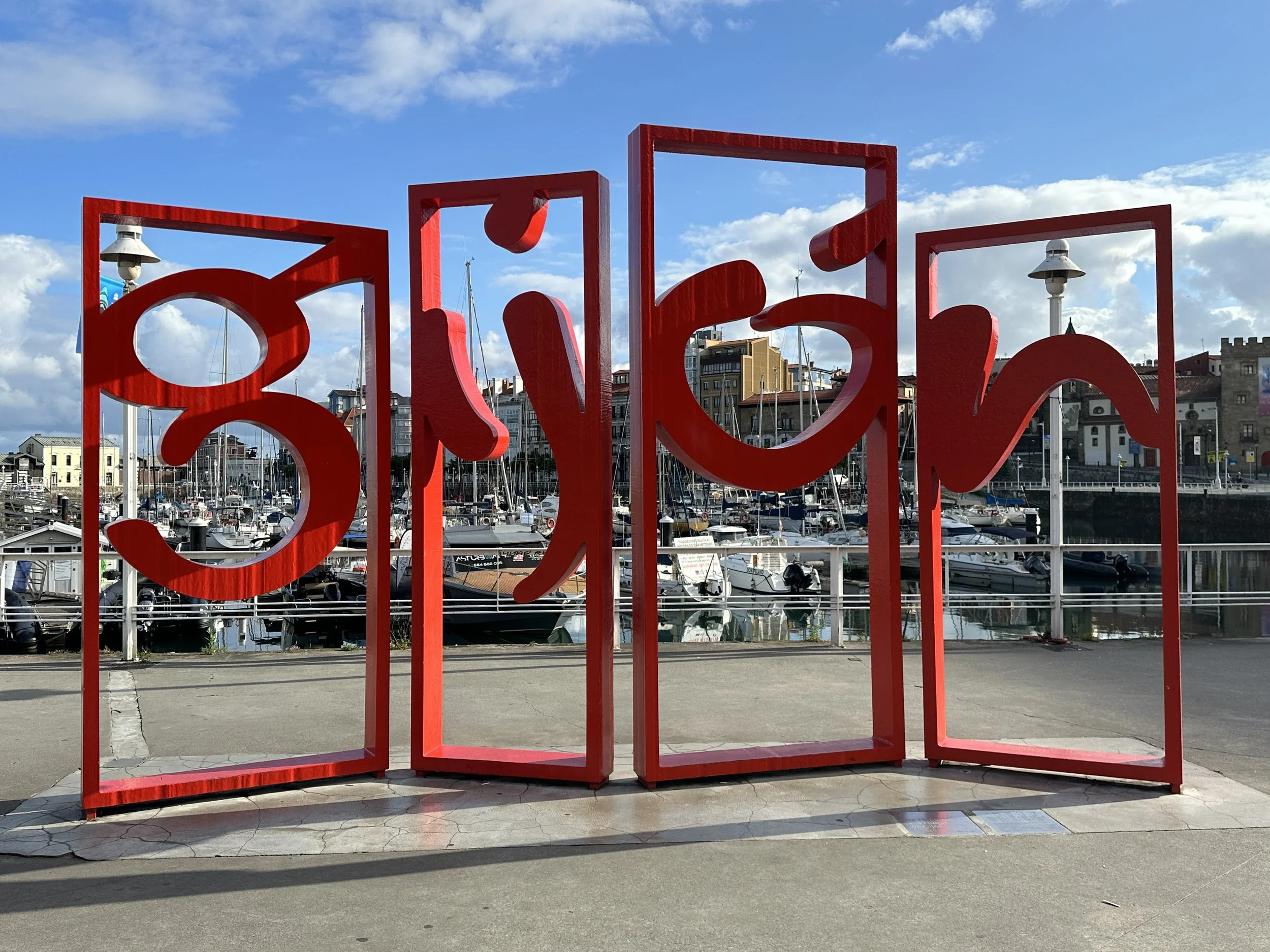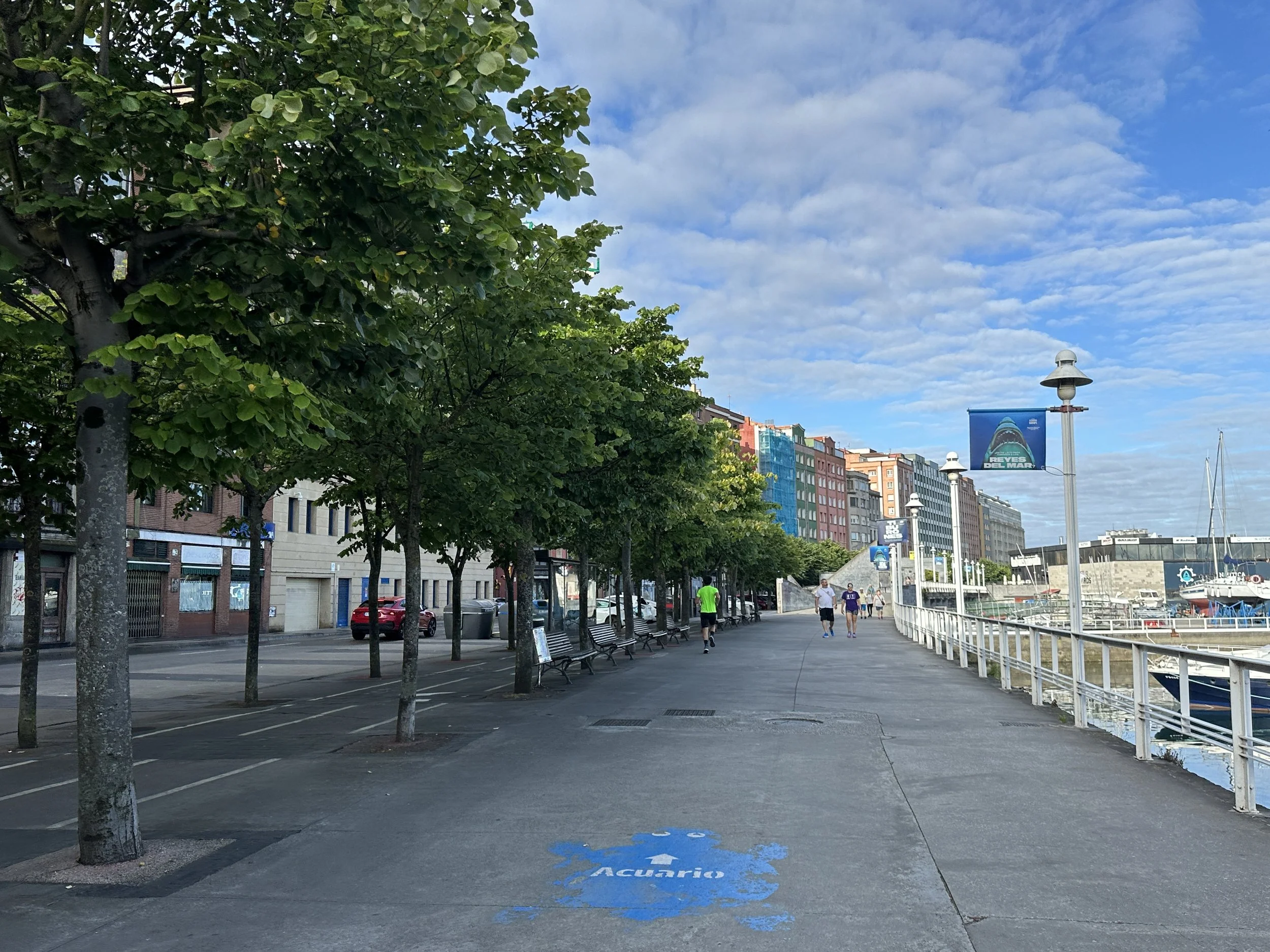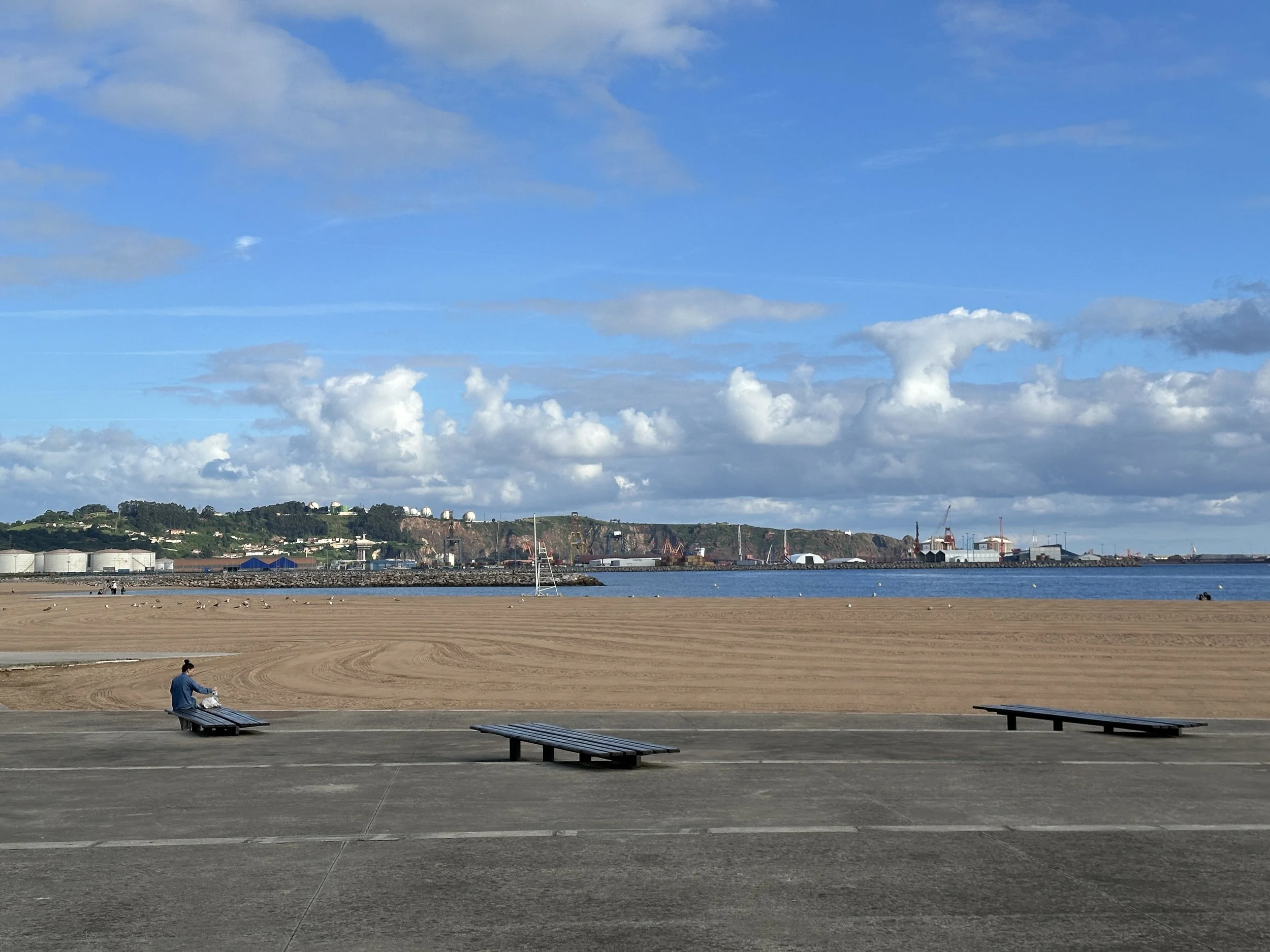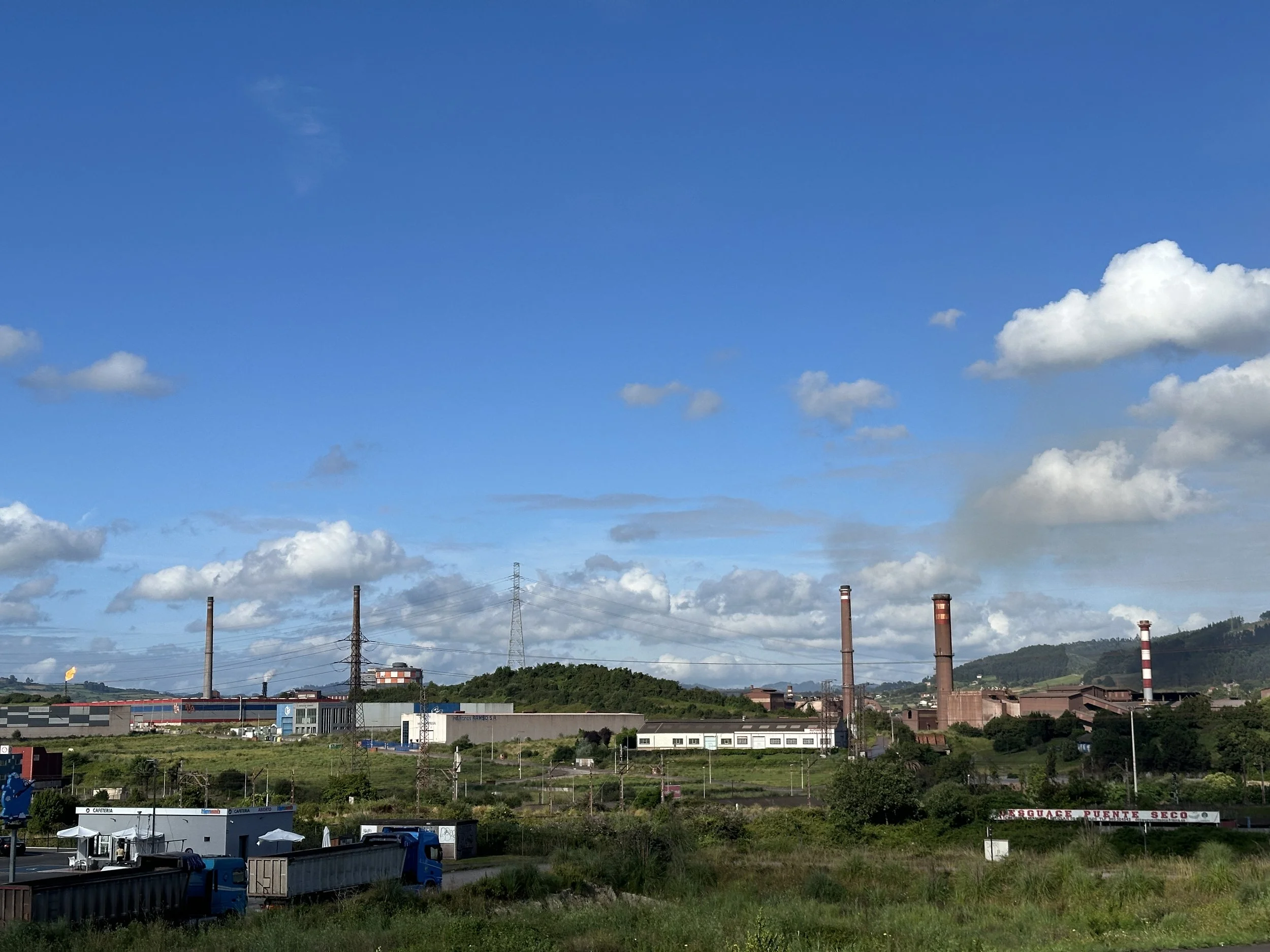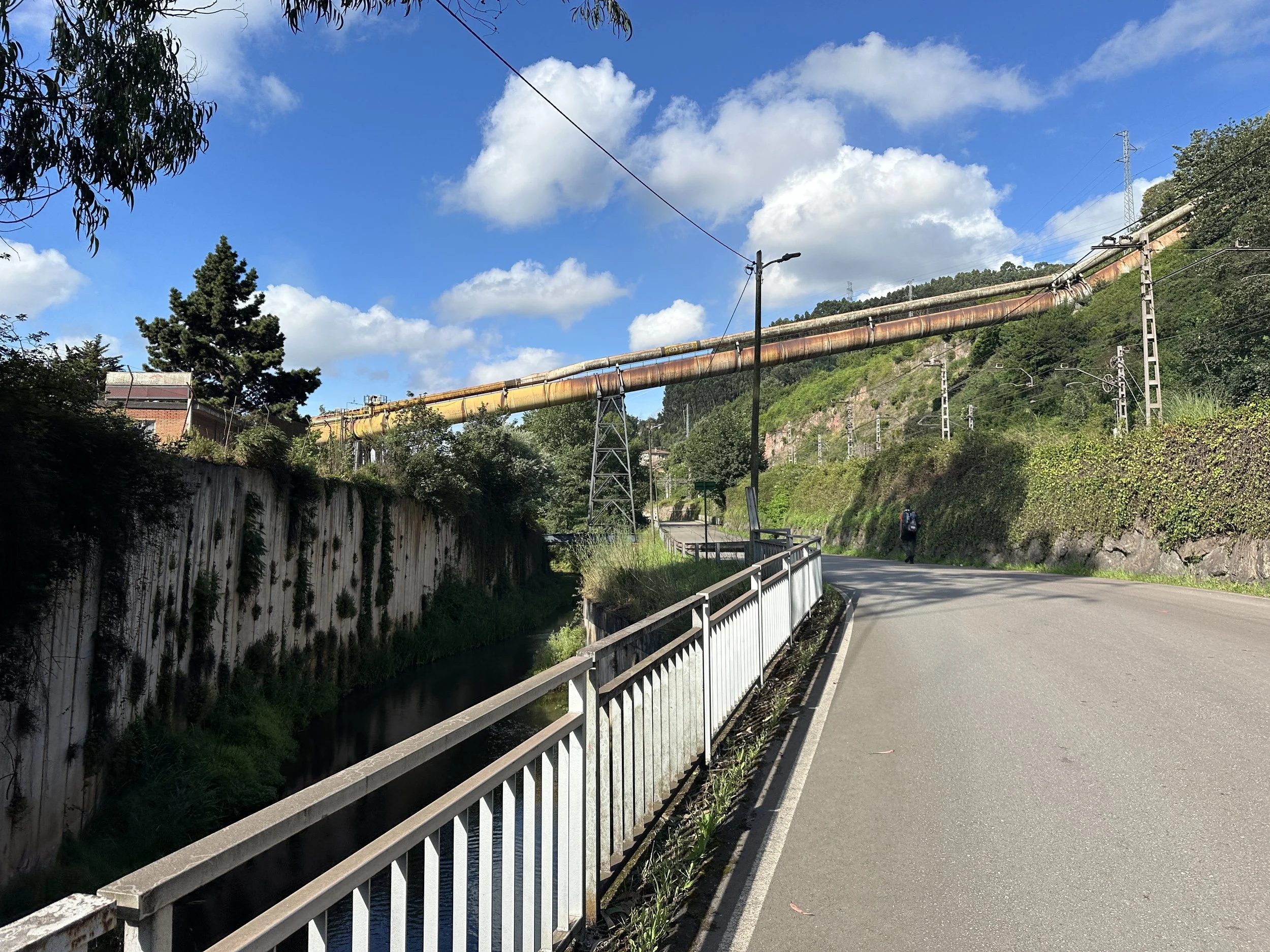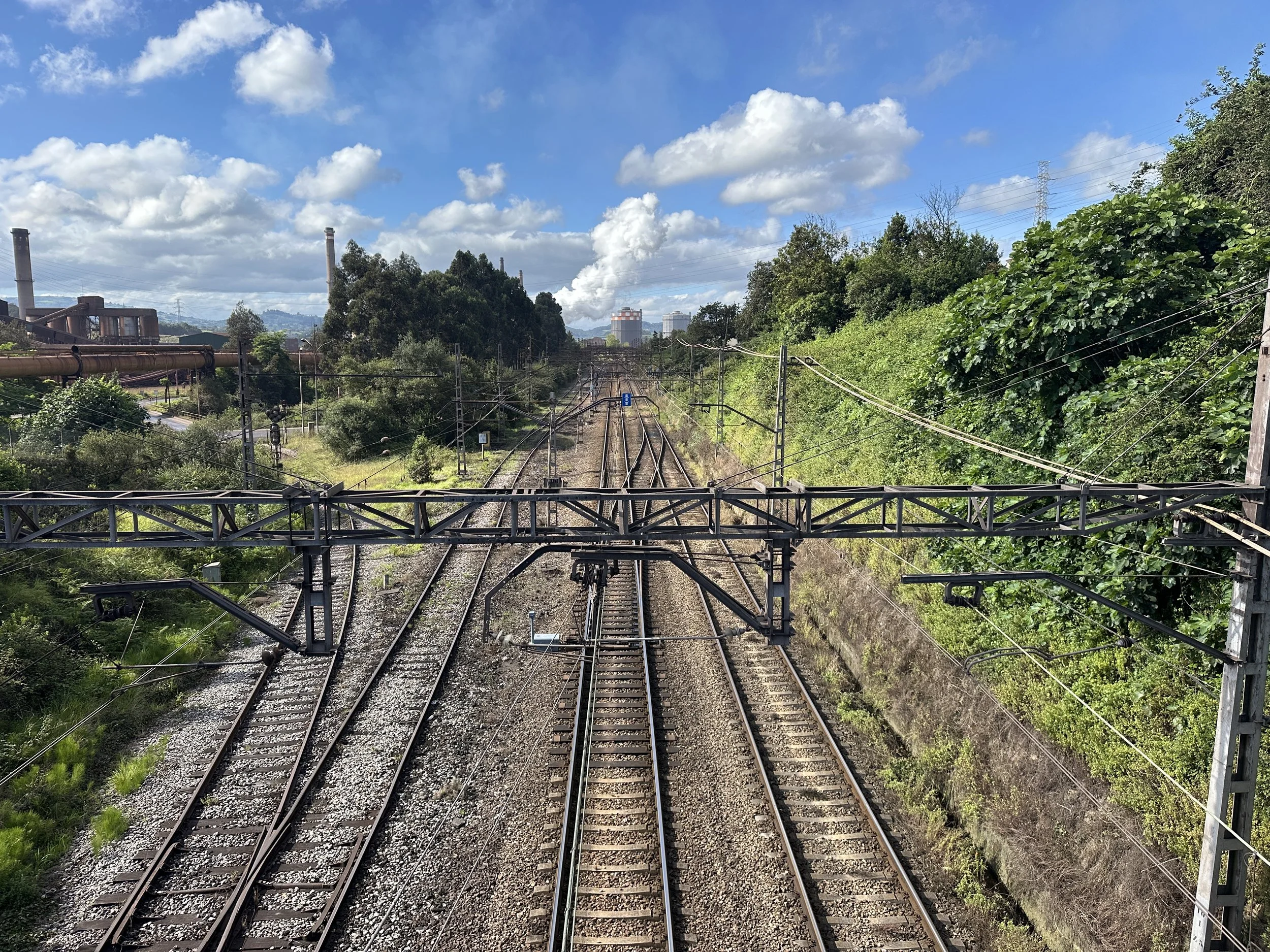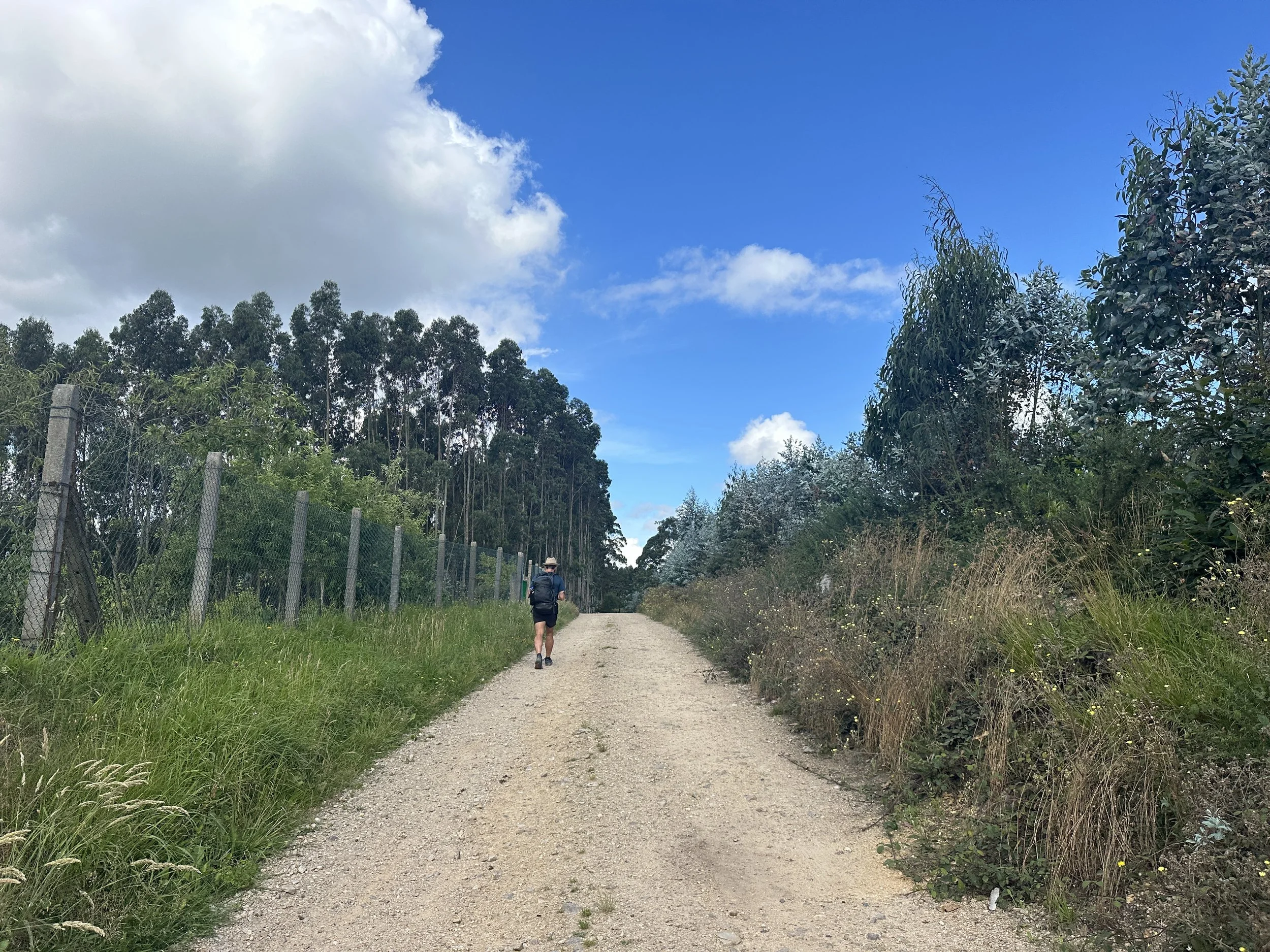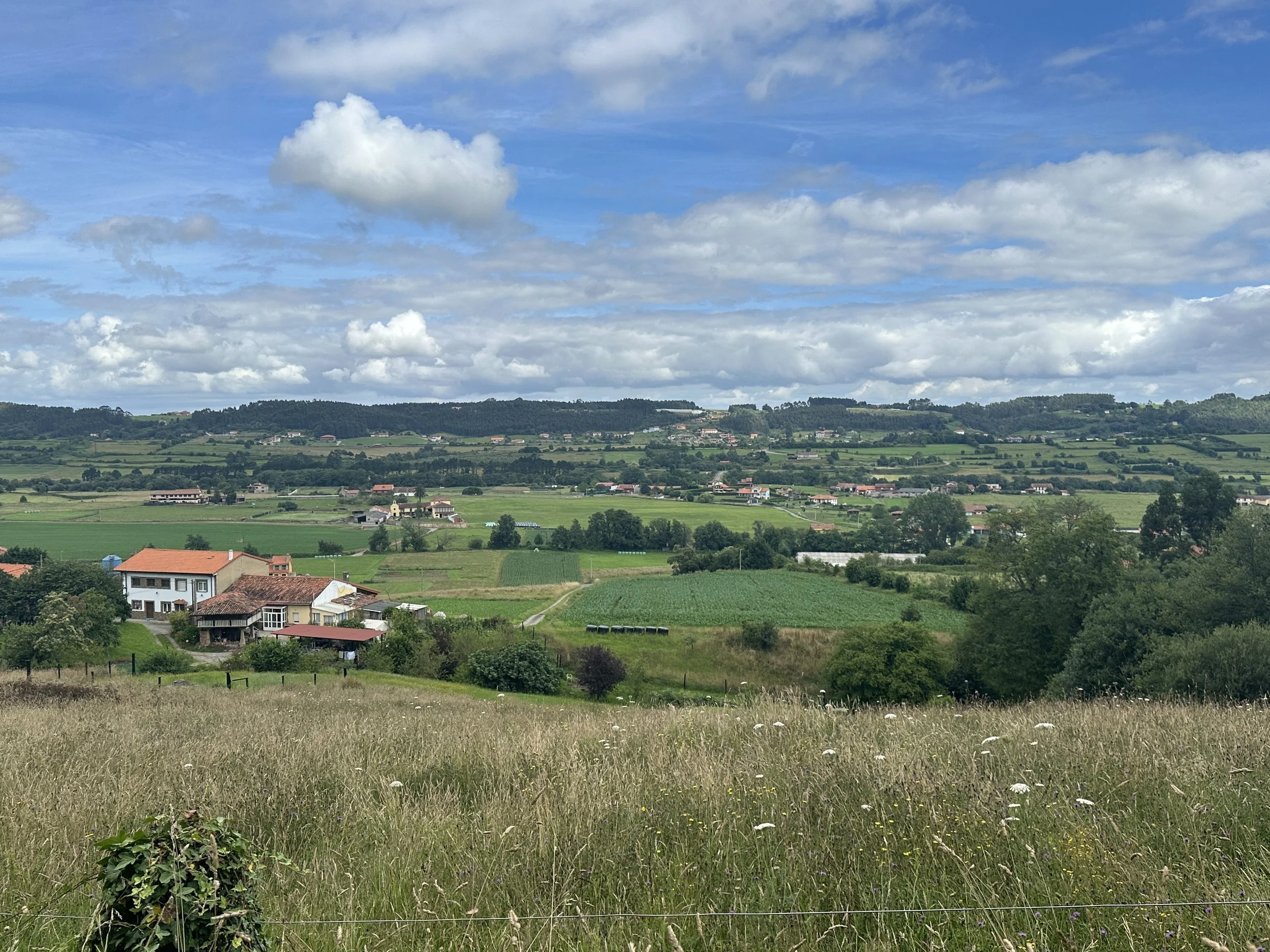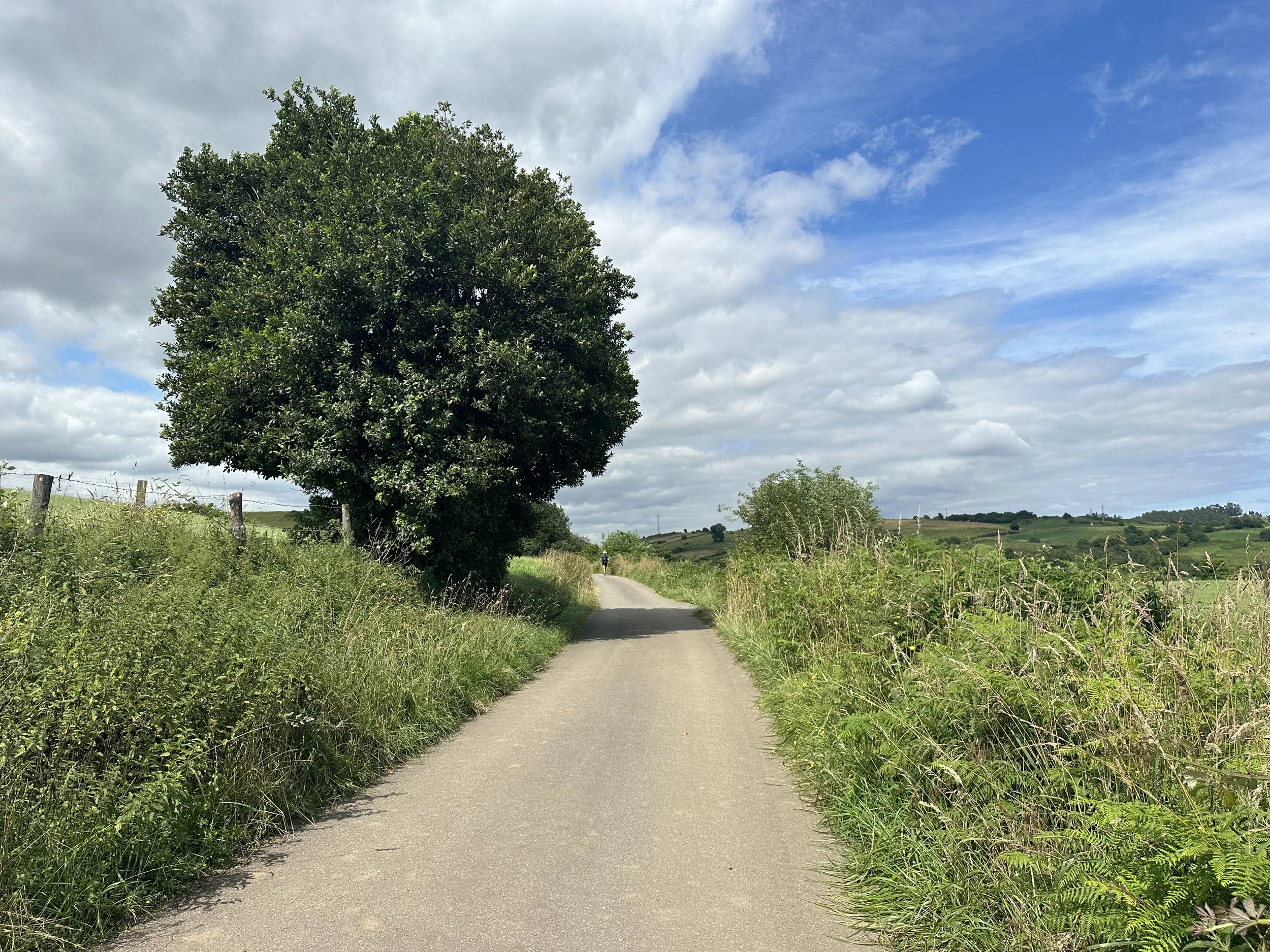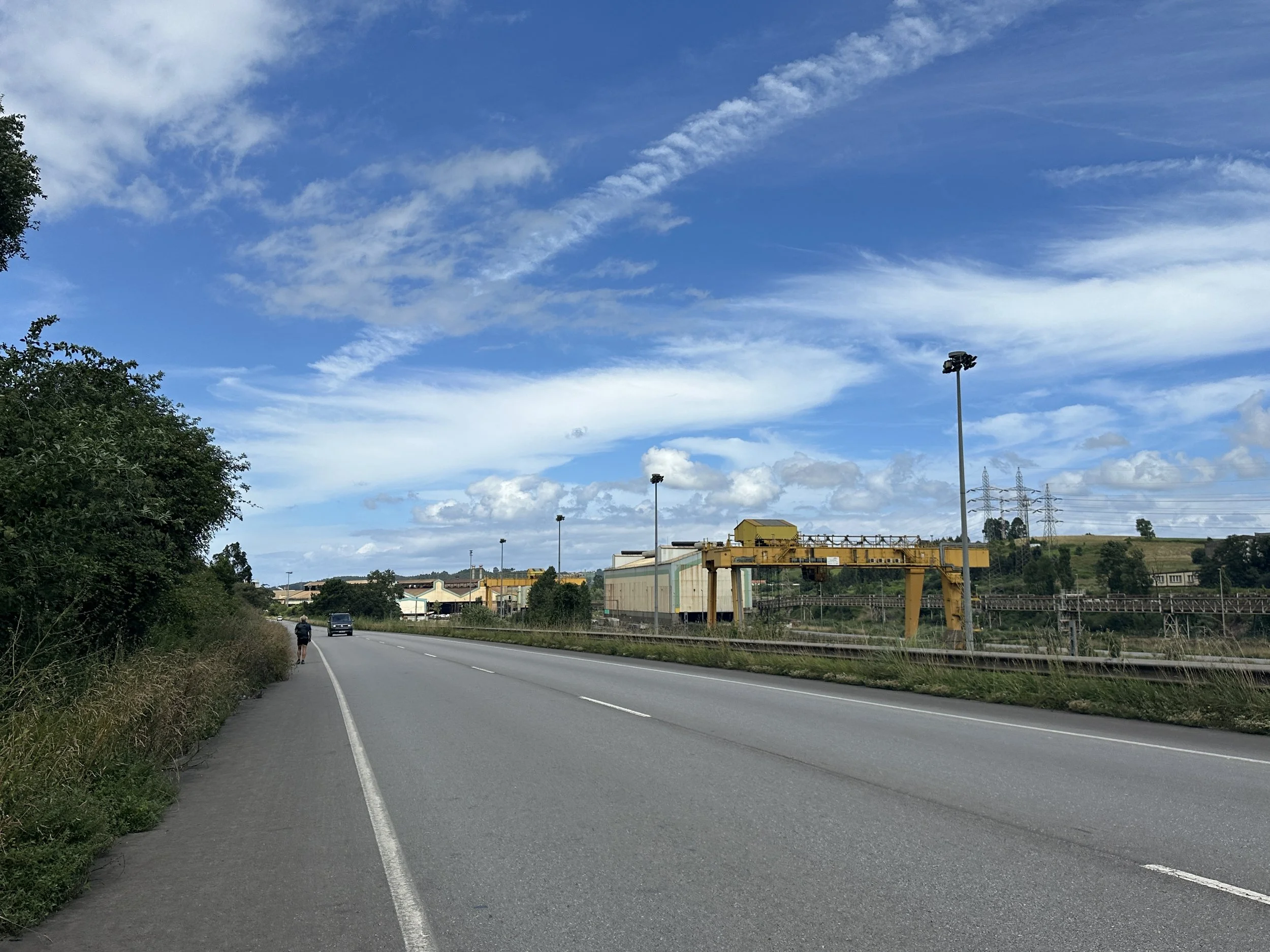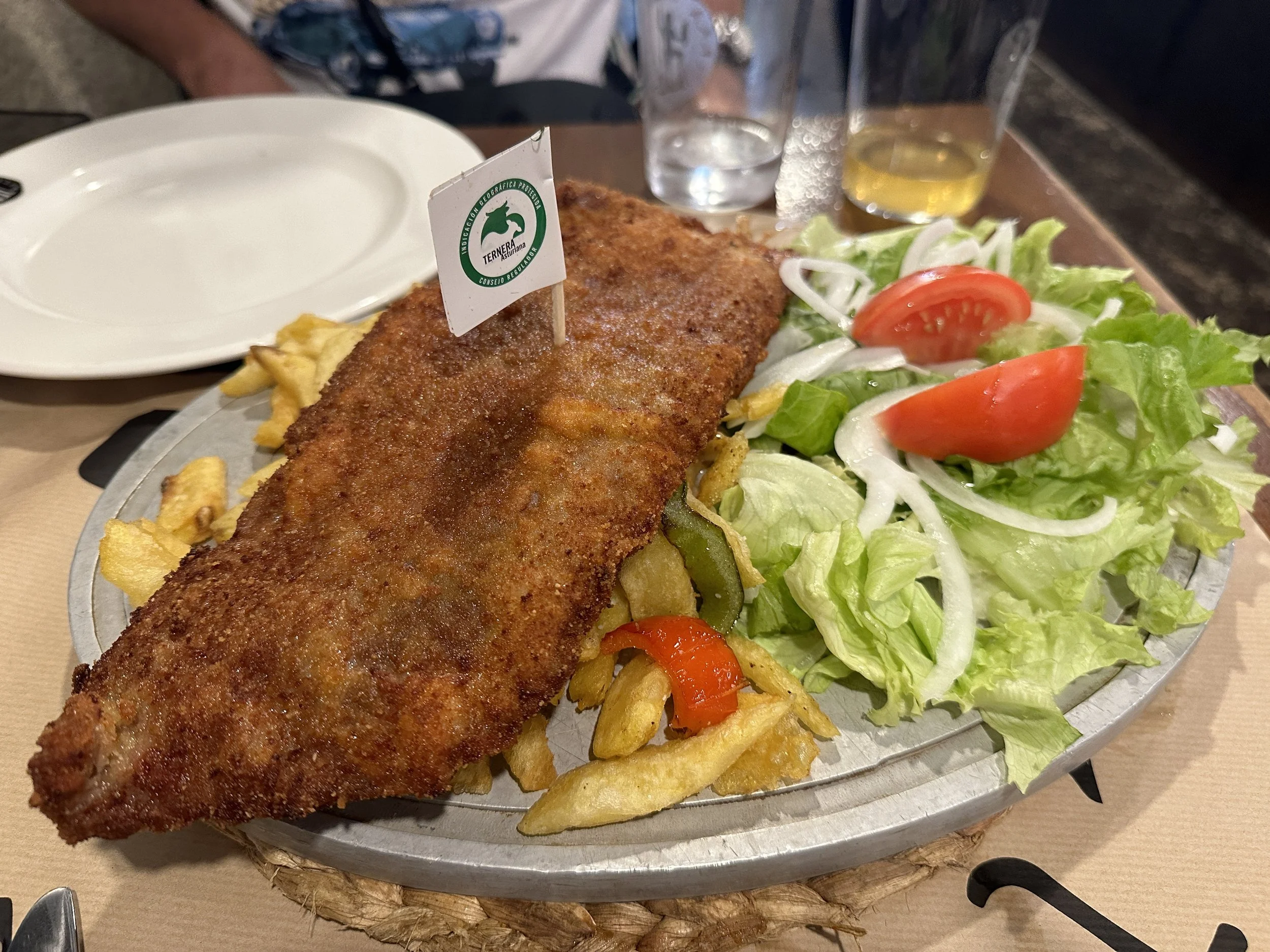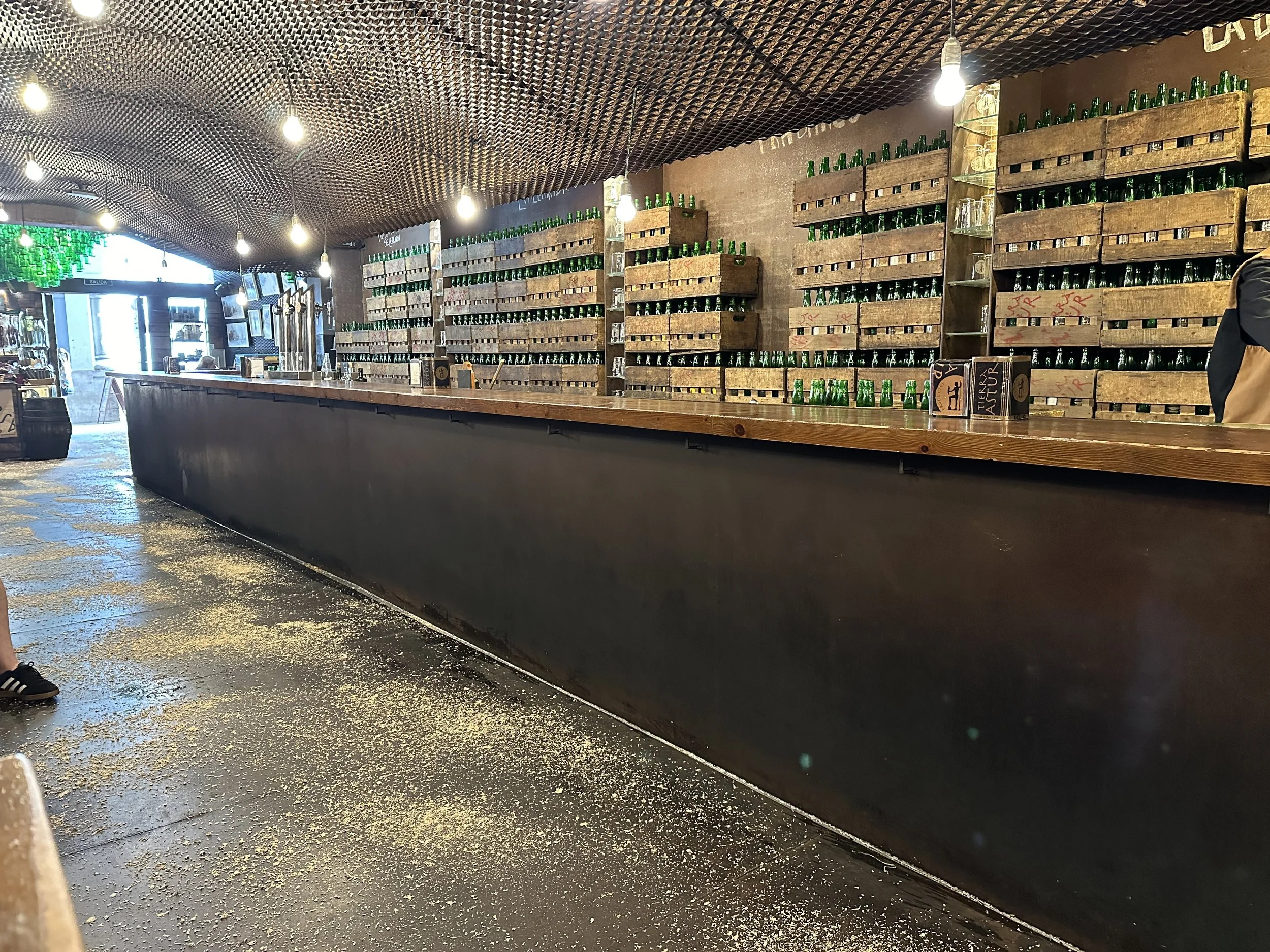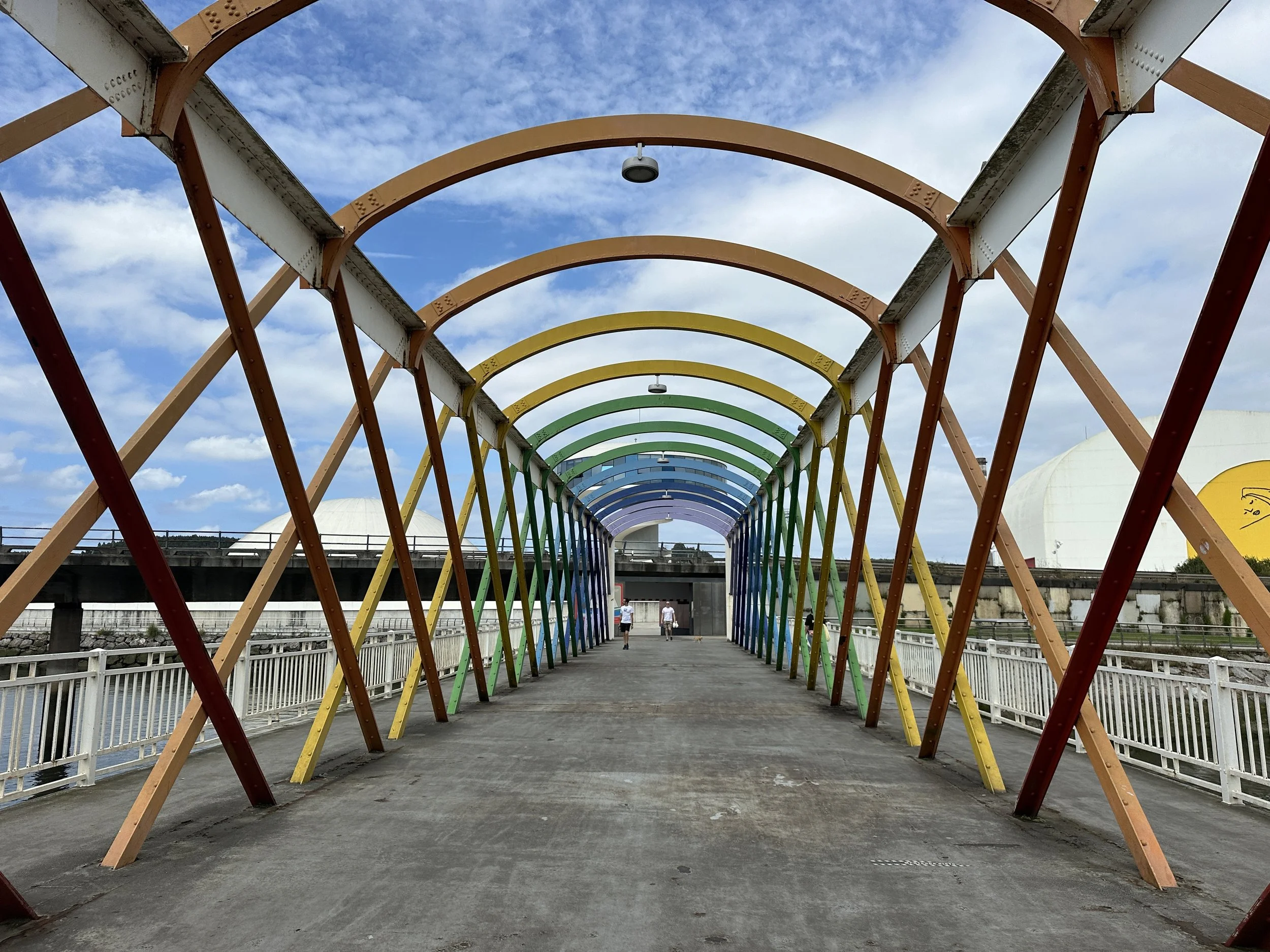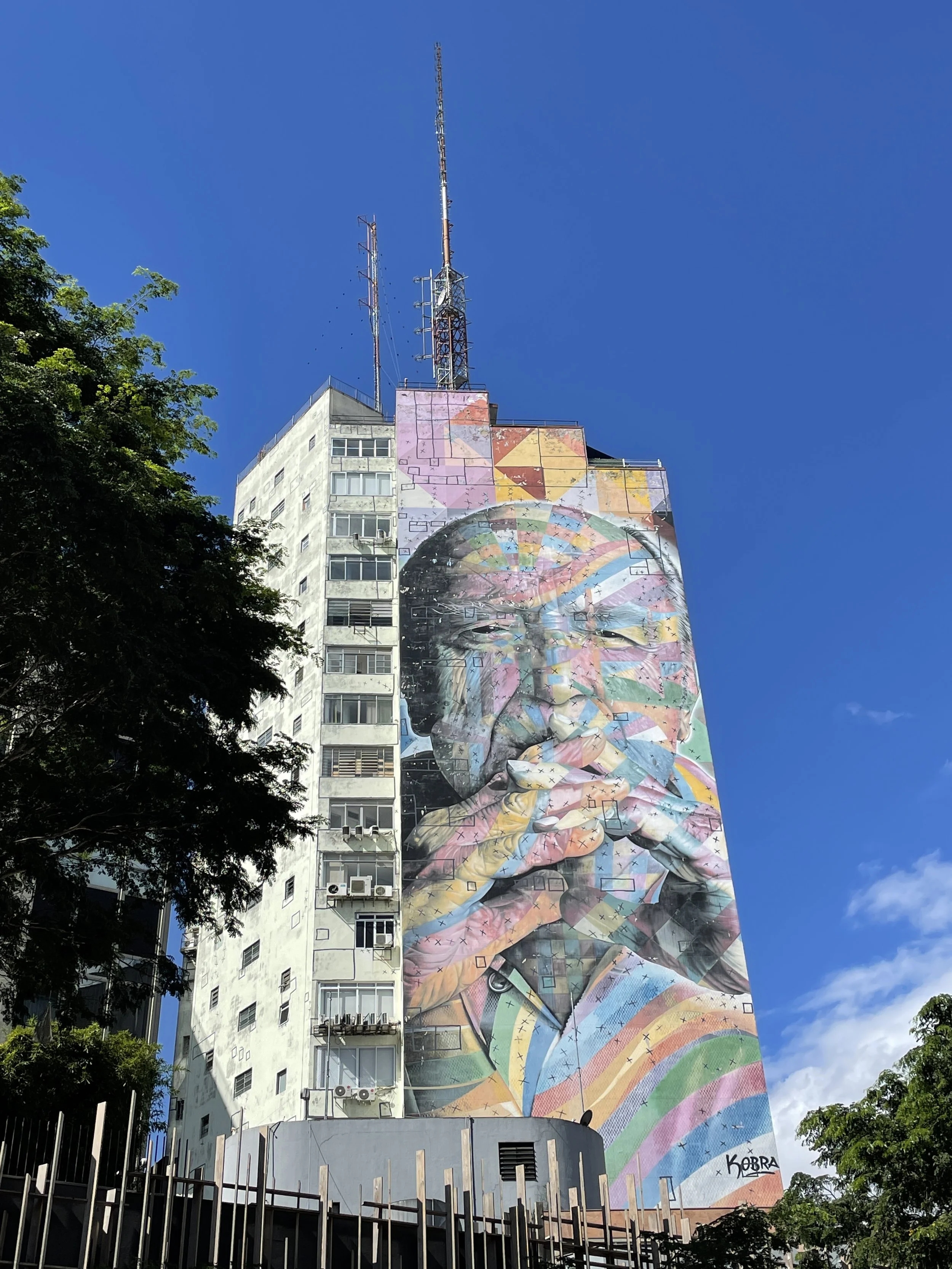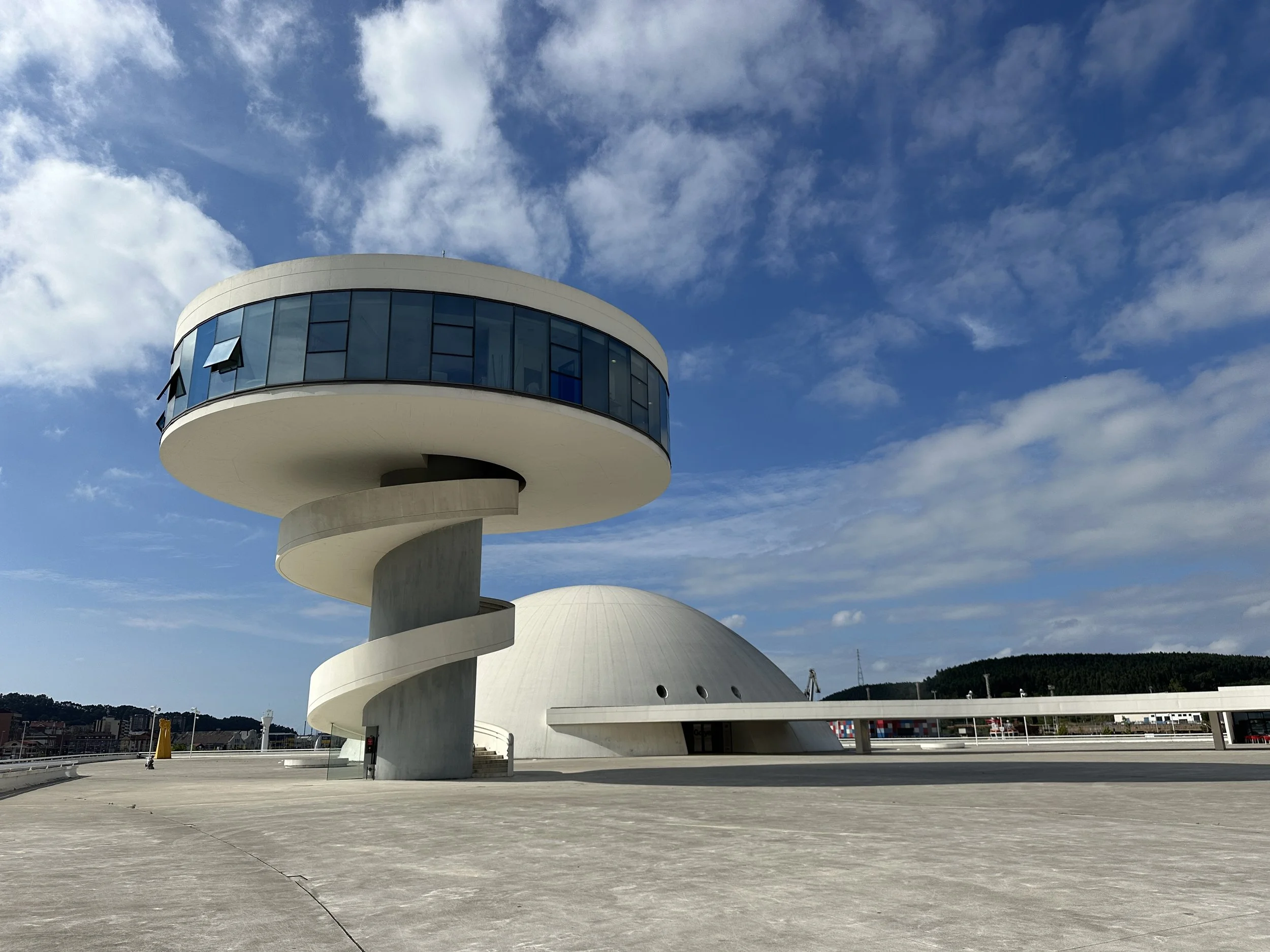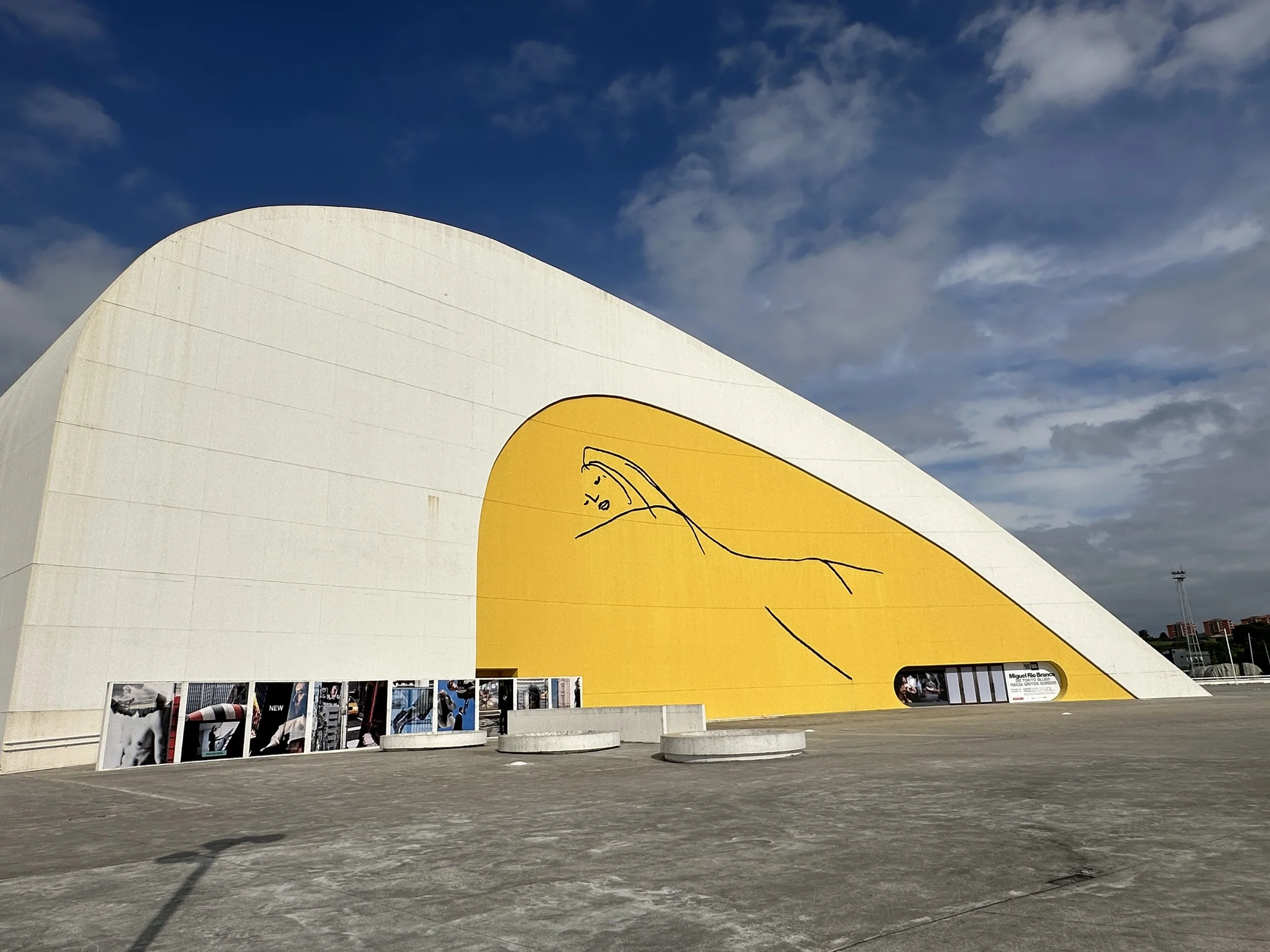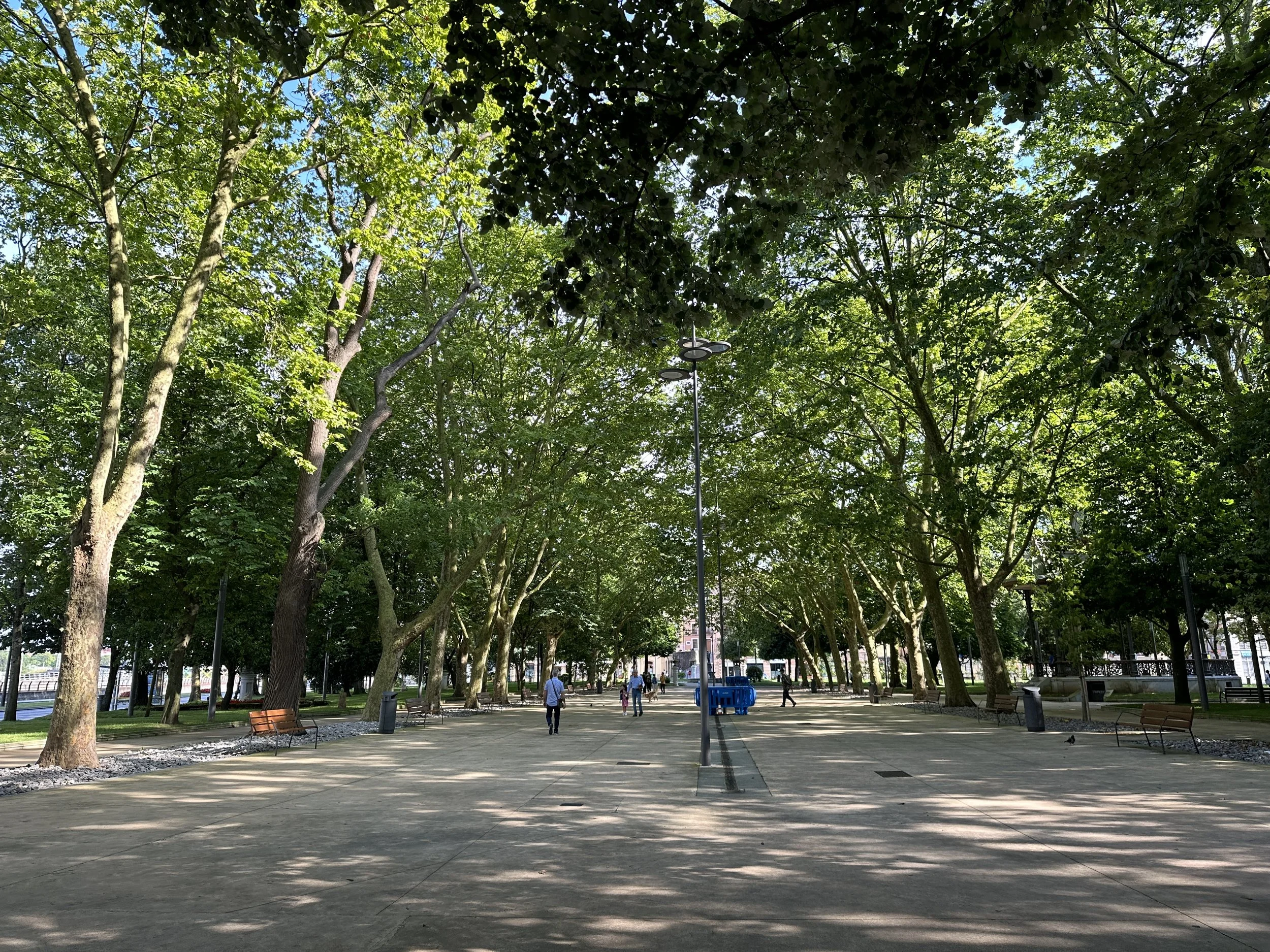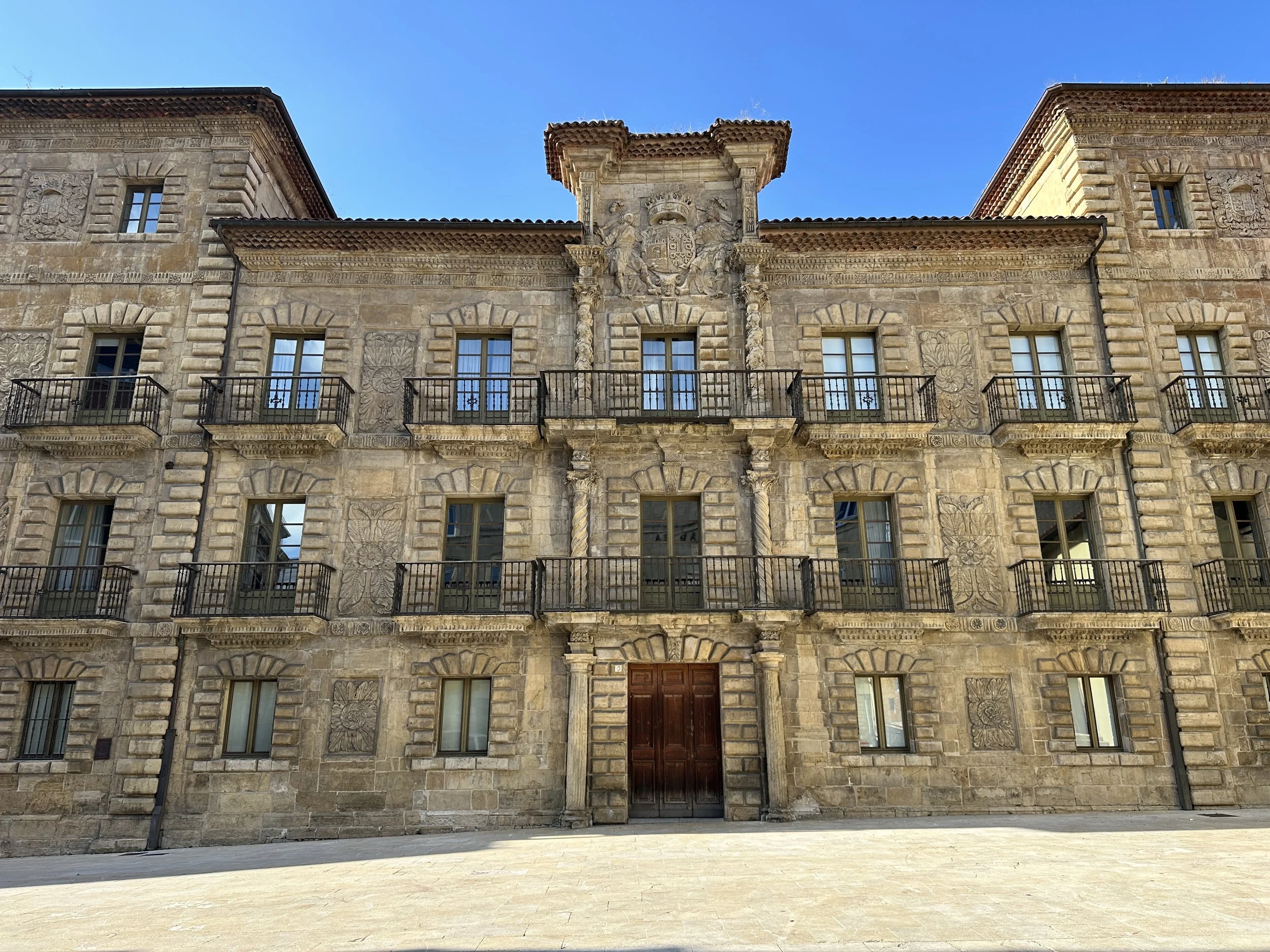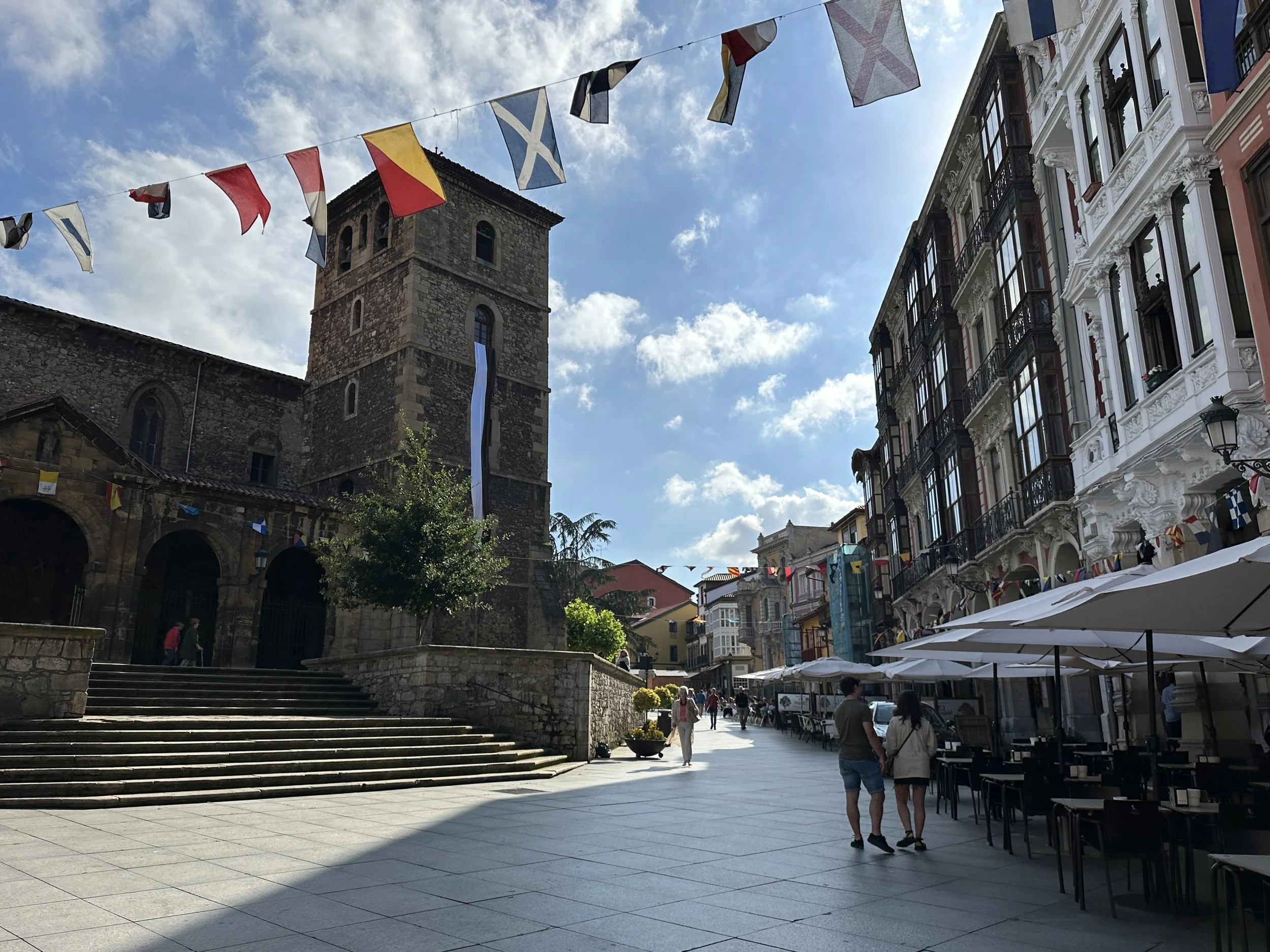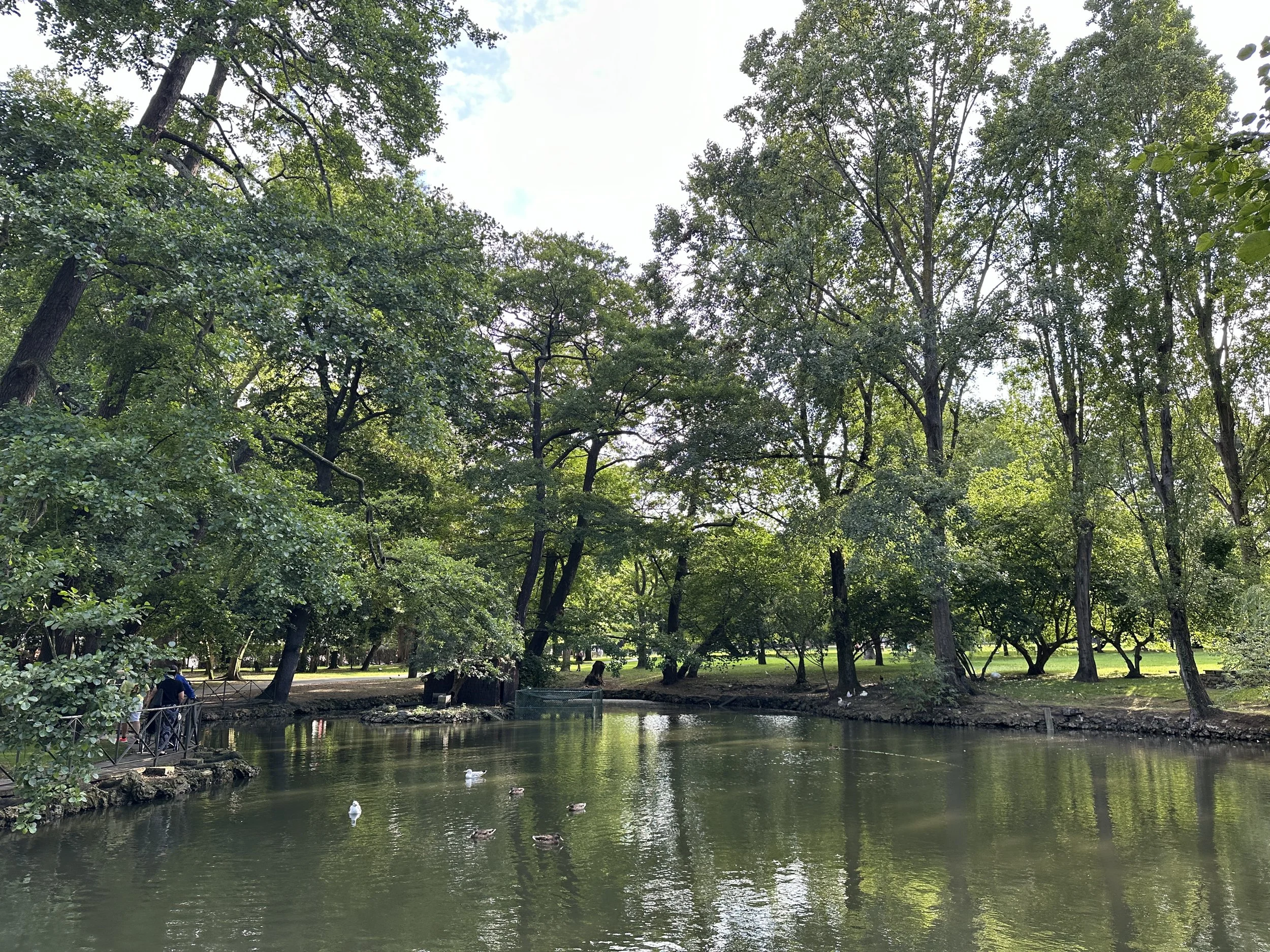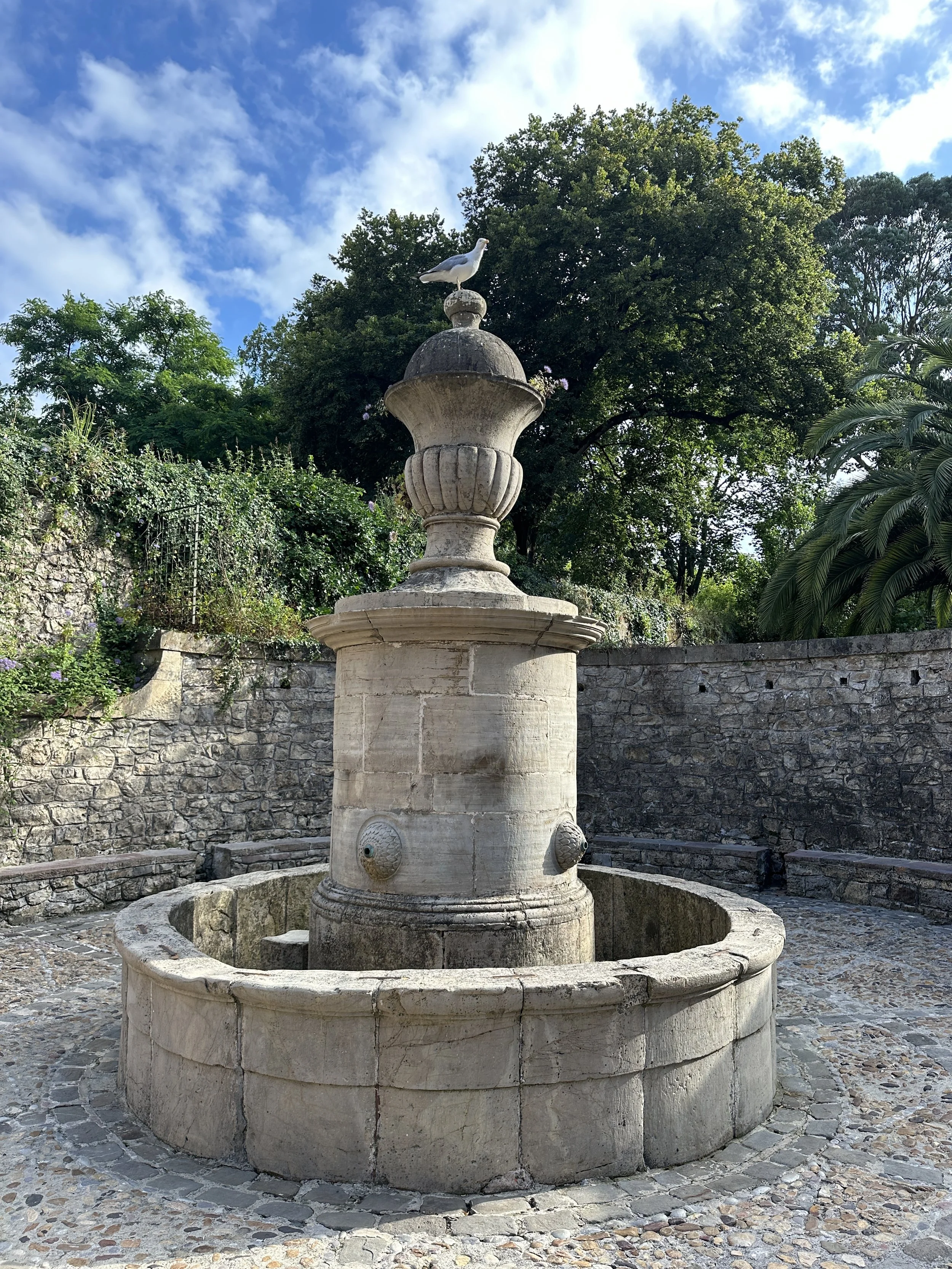Day 29 - Gijón to Avilés
Date: Saturday July 13
Start: Gijón, Asturias
End: Avilés, Asturias
Daily Mileage: 16.1mi (25.9km)
Total Mileage: ~324.4mi (522.1km)
Today we woke to a beautiful morning. After finding a bite to eat at a cafe in Gijón, we set out under blue skies. Walking along the marina, the sun lent an entirely new atmosphere to the city than the dreary gloom we’d experienced yesterday. Bright and cheery. Many were out walking, running, and bicycling along the promenade and pedestrian paths that ran along Gijón’s waterfront.
The route for today was widely advertised in guidebooks and blogs as “the worst walking day along the Camino del Norte.” Both leaving Gijón and entering our next destination, Avilés, it was reported to go through the industrial outskirts of the cities, a blight on the landscape (and the route). Many pilgrims opted to skip this section altogether, taking a bus ahead to Avilés. For our part, we decided to walk the route anyway.
Mentally, it helps that you know what you’re getting yourself into. We now had in mind that it might not be the best scenic day along the trail, and – while we doubted it would be all that bad – if all else failed, podcasts would see us through.
All that said, we found the ‘worst day of walking’ report to be overdramatic. Most of the day was actually pretty pleasant.
Walking out of Gijón, I thought about our very brief time there. Despite our gray weather yesterday, I had really liked the city. There are really no major sites or attractions (beyond the beach), but there is plenty of life – many nice parks and plazas, smaller museums, busy pedestrian streets/corridors, great sidewalk cafes, and a host of traditional sidrerias (though we didn’t partake here).
The first couple of miles of the hike led us out of the city center and westward through Gijón. Entering and exiting the major cities along the Camino always includes a bit of walking along the fringes of the city. Some entrances/exits are better than others – a hilly park that drops you down into town, for example. But on occasion you need to go through a bit of the grittier side of the cities – the fringes with the auto dealerships, mechanics, lumber yards, and factories.
I’ve always liked watching the transition as you head into and out of cities. Since Shawn and I do a fair bit of overland travel by bus and train, there has been ample opportunity to watch cities and towns morph from the edges to the center, or vice versa. You can often glean a lot about a city via its fringes. How quickly outside of the city center does infrastructure and liveliness begin to deteriorate? Where does the busy sidewalk traffic end? Do the plazas and gathering spaces dwindle or does the city maintain these healthy spaces through its edges?
Of course, I acknowledge that – particularly on a hike – we are only walking a single transect through the city... we are not seeing all the districts and neighborhoods. Only the tiniest of slices. But it’s interesting to watch the transition nonetheless.
Entering Gijón on Thursday afternoon, the hike had brought us in through quiet well-landscaped suburbs. People dined on sunny terraces. It was clearly a more affluent – at least reasonably so – area of the city. Vibrance and affluence are not the same though. It need not be the richest part of the city to host healthy vibrant neighborhoods. Today I wondered what we’d see as we walked out the western side of the city.
The walk ended up to be exactly this – a beautiful Saturday morning, the sidewalks were well traveled, shop doors flung open, and people chatted in the streets. There was nothing spectacular or glitzy about the street or surroundings – a mix of small shops, restaurants, and apartments – but it all felt very homey and loved for the most part. It was pleasant city walking.
The fringes of the city along our route would actually meet a very abrupt transition, though. About two miles from the city center, a single roundabout seemed to signal the boundary between livable city and industrial outskirts. The towering smokestacks of a massive steel manufacturing plant came into view. There was literal fire on the landscape, an incinerator bellowing flame in the distance. The air was tinged with the acrid smell and taste of metal. The kind you can taste.
Shawn and I continued toward the factory, weaving our way along side roads that led by an abandoned-looking building where something else metallic smelling burned in a barrel outside. A dog slept in the sun on the road. Roosters crowed from the tall weeds in the ditches. Homes perched high in the hills were abandoned, crumbling with neglect.
Crossing under a highway past an abandoned weigh station, we walked along a short stretch of river, following a road that slowly weaved its way up into the hillsides, offering more views of the enormous steel manufacturing operation, a scare on what was otherwise the typical Asturian landscape of rolling green hills. I felt bad for those that lived in the homes along the hillsides that we passed. Built in great locations overlooking what was likely once a nice green valley, the view now housed a tremendously hideous factory. It was hard to believe anyone would have put a home there after the factory was already built.
Some of those are clouds, but that vertical shaped one in the center, not so much.
Winding our way up through the hillsides, the roads steepened and then mellowed. Then steepened again, depositing us on a flat, shaded, quiet gravel path through the Monte Areo recreational area, A large area of forested land and the occasional field, it was pleasant walking.
The remainder of the morning and early afternoon continued to be quite pleasant. While it was all road walking, it was along quiet country roads, with no cars to speak of through the bulk of the journey. There were some views over the surrounding countryside as we descended to a wide flat valley and through a small town where, just under halfway through our walk for the day, we were happy to find a water fountain at the Iglesia de Santa Eulalia del Valle, a small church along the route.
The walking from here was flat and easy. Though the day was bright and blue, and most of the route was quite exposed, there were enough clouds to shroud us from the worst of the sun and light breezes to keep us cool as we walked. The landscape was a mix of fields – crops, weeds, flowers – sometimes tall grasses in the ditches blocked any further view. But it was always green.
About five miles outside Avilés, we began to go through more ‘fringe’ areas. More industrial factories. More metallic smell in the air. While I had found the industrial stretch out of Gijón to be pretty short (and in some ways, somewhat interesting), the stretch leading through the industrial areas and small towns outside of Avilés was mostly along highway, which left me far less enthusiastic. Podcasts saw us through. And the bread and sliced chorizo that Shawn had picked up for us in the grocery store yesterday afternoon. We munched as we walked. With only a few miles to go, we were keen to keep walking, but also needed a bit of a snack to tide us over on the 16+ mile journey.
Once we got further into Avilés proper, the route eventually wound us through some back streets and onto a nice pedestrian path along the Rio Albares for most of the remainder of the walk into the city. By this point my feet were getting a little sore from pavement walking and I was ready to relax. (Shawn will tell you that I never relax, which is mostly true).
Fighting city crime. One utility box at a time.
Heading in toward the city center, we walked through the historic area, which passed through beautiful streets of colorful homes and buildings, and the Plaza de España, with its regal town hall. The plaza was alive with the din of the surrounding cafes. Glasses and silverware clanking. People chatting. It was a beautiful Saturday to be enjoying lunch on the square.
Avilés City Hall.
Our hotel was also located in the historic center, not too far from the plaza. After checking in and showering, we headed back out to find some lunch. Now late in the afternoon (after 4pm), many of the restaurants would be closing for siesta soon. Time was of the essence.
On our way out of the hotel, we ran into Andy, who was also checking in at our hotel. We kept the banter brief, due to the aforementioned desire to find lunch, but had a short chat. Andy had taken the bus today, as he had told us was his plan when we’d walked with him into Gijón on Thursday. He’d taken his time in Gijón in the morning, heading to the beach and running some other errands before making his way here. We told him the hike wasn’t so bad actually, most of it pleasant other than the last highway bit into Avilés.
With that, we left him to finish his check-in while we continued back to the plaza area, getting lunch at a lively sidreria, where we shared a large plate of cochopo and a bottle of cider.
How the cider is poured. (If you’re reading this blog as an email, you will likely need to go to the actual blog to view the video.)
A traditional cider house, the waiters poured the cider for you, holding the bottle high in the air and pouring into the glass far below. The cider would splash just along the edge of the glass, a target that seemed very close to missing the glass altogether. Each time, they would pour only a small amount and when they saw that your glass was empty, they would be by again to refill it. Owing to the pouring method, which creates a bit of splashing, the floor was dusted in sawdust, another attribute of traditional sidrerias. (Though they forgo the sawdust at the sidrerias where they are using the electronic bottle/straw contraptions to pour/aerate the cider). This was the first place we’d been that had the sawdust on the floor.
A lightly sawdusted floor for cider splashes.
We finished lunch with some really tasty ice cream sandwiches made with turrón, another nougat confection, though this one - particularly when served with an ice cream/cookie sandwich, was quite good. Everything is better with ice cream. And chocolate.
After lunch, Shawn went back to the hotel to catch up with the Tour de France coverage, while I did a bit more strolling and exploring. First up was the Oscar Niemeyer Center. Oscar Niemeyer is a Brazilian architect who we were very familiar with from our travels in Brazil. In addition to seeing/visiting a number of buildings/museums that were designed by him, Kobra – one of our favorite street artists – had painted a giant mural of Niemeyer along the side of a tower on Paulista Avenue in São Paulo. He is a bit of a big deal in Brazil, and in the architectural world in general.
Photo taken when we were in São Paulo, March 2022.
Here, in Avilés, the international cultural center – a set of several buildings set along former industrial land across the river from the historic center – was designed by Niemeyer. The center hosts a wide range cultural events/exhibitions, ranging from theater to concerts, dances, films, and art exhibitions. While the unique architecture of the cultural center was reason enough to visit, they also had an exhibition of works by Francisco Goya, in addition to some pieces by several other artists, including Picasso, Botero, and Dali, among others.
After visiting the cultural center and a walk around the exhibition, I walked around a bit more of Avilés’ historical center. It was a beautiful Saturday evening, and the parks, plazas, and open spaces were all lively. The skies were brighter now than when we had originally walked in and yellowed brick of the historic center seemed to glow a bit in the sunlight.
Parque de Muelle
Along the promenade on the west side of the river, there were a series of historic photos of the riverfront port area where I now walked. The boats currently moored looked very different than those in the photo. The photos were an interesting look into the past and a fun addition to the waterfront.
Palacio de Camposagrado
There were shady parks, old palaces, weathered churches, and even small artistic pleasures, like colorful tiles inlaid in the sidewalk along an otherwise inconsequential little side street. Art has the ability to improve any space.
Avilés is truly a beautiful city and it was such a nice evening, it was hard to head back to the hotel. But, back at the hotel, we did have the chance to FaceTime with our nieces, which was also a nice way to cap the day.
Iglesia San Nicolas de Bari
Sometimes when we get to a town we are, understandably, already tired from walking all day. It may not sound appealing to go out and explore much beyond those streets immediately near our hotel – which is often mostly to find a meal. But I’m so glad I took a longer walk around Avilés. I never regret going a little further afield, and this was a beautiful city to wander. A true gem, worth a bit of ugly highway walking to reach.
I’ll leave you with a few more photos:

